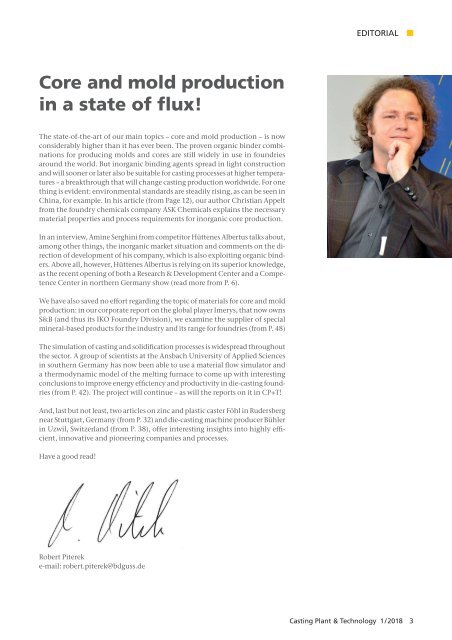CPT International 01/2018
- No tags were found...
Create successful ePaper yourself
Turn your PDF publications into a flip-book with our unique Google optimized e-Paper software.
EDITORIAL<br />
Core and mold production<br />
<br />
The state-of-the-art of our main topics – core and mold production – is now<br />
considerably higher than it has ever been. The proven organic binder combinations<br />
for producing molds and cores are still widely in use in foundries<br />
around the world. But inorganic binding agents spread in light construction<br />
and will sooner or later also be suitable for casting processes at higher temperatures<br />
– a breakthrough that will change casting production worldwide. For one<br />
thing is evident: environmental standards are steadily rising, as can be seen in<br />
China, for example. In his article (from Page 12), our author Christian Appelt<br />
from the foundry chemicals company ASK Chemicals explains the necessary<br />
material properties and process requirements for inorganic core production.<br />
In an interview, Amine Serghini from competitor Hüttenes Albertus talks about,<br />
among other things, the inorganic market situation and comments on the direction<br />
of development of his company, which is also exploiting organic binders.<br />
Above all, however, Hüttenes Albertus is relying on its superior knowledge,<br />
as the recent opening of both a Research & Development Center and a Competence<br />
Center in northern Germany show (read more from P. 6).<br />
We have also saved no effort regarding the topic of materials for core and mold<br />
production: in our corporate report on the global player Imerys, that now owns<br />
S&B (and thus its IKO Foundry Division), we examine the supplier of special<br />
mineral-based products for the industry and its range for foundries (from P. 48)<br />
The simulation of casting and solidification processes is widespread throughout<br />
the sector. A group of scientists at the Ansbach University of Applied Sciences<br />
in southern Germany has now been able to use a material flow simulator and<br />
a thermodynamic model of the melting furnace to come up with interesting<br />
conclusions to improve energy efficiency and productivity in die-casting foundries<br />
(from P. 42). The project will continue – as will the reports on it in CP+T!<br />
And, last but not least, two articles on zinc and plastic caster Föhl in Rudersberg<br />
near Stuttgart, Germany (from P. 32) and die-casting machine producer Bühler<br />
in Uzwil, Switzerland (from P. 38), offer interesting insights into highly efficient,<br />
innovative and pioneering companies and processes.<br />
Have a good read !<br />
Robert Piterek<br />
e-mail: robert.piterek@bdguss.de<br />
Casting Plant & Technology 1 / 2<strong>01</strong>8 3


















